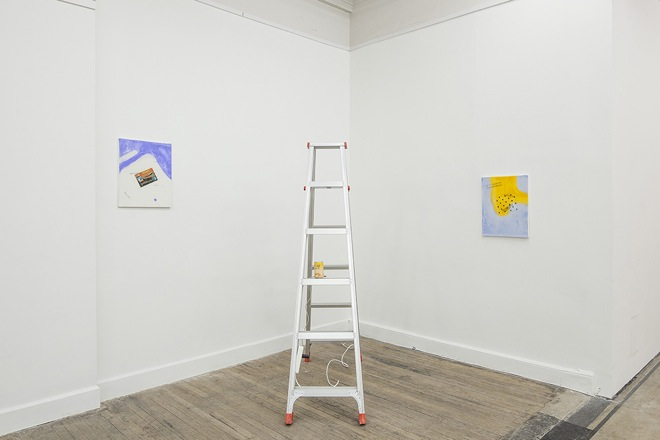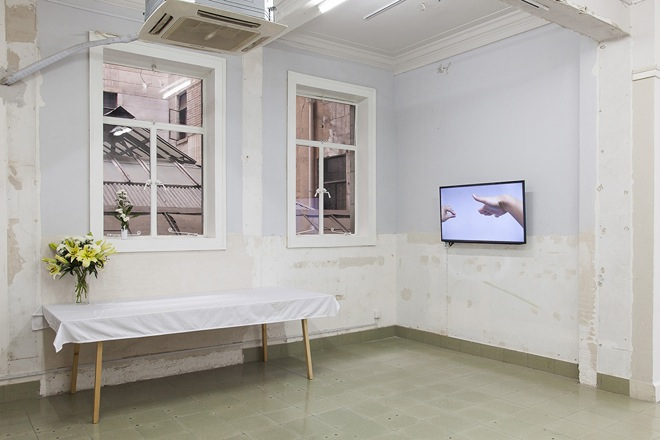“Topophilia”: group exhibition with Chen Chieh-jen, Heman Chong, Victoria Fu, Rania Ho, Lee Kit, Michael Lin, Arthur Ou, Wu Chien-Ying, Jun Yang, Amy Yao, Patty Chang & David Kelley
BANK (Xianggang Lu No. 59, Huangpu, Shanghai) Mar 15–May 9, 2014
Shanghai revels in architecture that could be called Ballardian, and the approach to BANK is no exception: located in a weathered 1920s bank edifice that has since been carved up and occupied by a variety of offices, the improbably well-lit space occupies the second floor, the ascent to which involves either a dark—if grand—stairwell or a miniature retrofitted elevator system. I visited on a day of gray drizzle, and the clammy lobby is overseen by an old woman knitting in a raincoat. Mathieu Borysevicz, formerly the director of the Shanghai Gallery of Art just down the street in a similar building that happened to be given a corporate makeover, has been called a “reluctant gallerist”, and it is obvious that he is having fun with his role. With “Topophilia”, he has assembled a striking group of works in a way that seems inherently suited to the space—both thematically (where better to explore questions of transience and identity in China than an abandoned bank on the Bund?) and on a finer level of curatorial detail: care for and interest in the work on offer is evident here; each work is provided with ample breathing room, and arranged in a way that encourages even the casual visitor to slow down.
Fortunately, this impulse is specifically indulged in this exhibition by Michael Lin, whose classic performative installation “Import” (2005/2010/2014) creates a space of temporary community with farmhouse tables and stools and refrigerated Taiwan-brand beer, reflecting on the function of commodity diplomacy as a major channel for the circulation of political ideas—or demands, top-down or otherwise—in contemporary China. This is a truly classic project, and one that picks up new functions each time it is exhibited: with a ballooning population of Taiwanese professionals in China, an increasingly isolationist cultural world in Taipei, and a Taiwanese administration nearly indistinguishable from that of the mainland, early gestures at cross-strait relations appear as quaint reminders of a not-so-distant past. One of the other classic works in the show, “Shangri-La” (2005), comes from Patty Chang and David Kelley, who built an angular, mirrored mountain with workers near the town formerly known as Zhongdian but now trademarked as Shangri-La. In its total and yet fragmented or, more generously, faceted reflection of its cultural context, the project acts as a formal echo of Heman Chong’s equally well-travelled “God Bless Diana” (2000-2004), which collects some five-hundred postcards printed with snapshots photographed by the artist on his perpetual travels, arrayed adjacent to the main entrance and appearing as something of a souvenir shop.

林明弘,《进口》,互动装置,尺寸不定,2005/2010/2014

张怡和大卫·凯利,《香格里拉》,录像,40分钟,2005

张奕满,《上帝保佑安娜》,装置,550张明信片,尺寸不定,2000-2004
Newer work comes from Arthur Ou, head of the photography department at Parsons New School of Design. His contribution to the exhibition, “View 2″ (2013) and “Primer” (2012) first appears as a diptych with two alluring monochromes in an unstably slate gray, wavering between painting and photography and yet clearly alluding to something beyond the frame. That something is, in fact, a volume of individual photographic prints perched on a shelf to one side, formally constituting a triptych and yet opening up a multitude of pathways into and very far beyond the larger pieces of the work. For Ou, this is a way of telling stories and reframing images— a contextual shift that appears again in the work of Lee Kit. Lee has always reused elements across his practice, and the history of an individual object is often contained within it, as with his textiles and pillows that accumulate traces of use over time. Here, with “Nothing blows it away” and “You” (both 2013), he explicitly makes visible the circulation of images across his video work, blog and painting; the closed systems of exchange between objects (and, only occasionally, people) in his installations have given way to more radically-immanent networks that bind together places and moments. Although his work for this exhibition is less performative, memories of the picnics and coffee dates that often baptize his objects resonate well with Michael Lin’s socially activated painting practice, just a wall away.
While many of these artists are hardly novel appearances on the Chinese exhibition circuit, some of the best work in the exhibition comes from two young, US-based artists with a fresh aesthetic and approach to their material. Amy Yao shows two of her “Untitled” (2013) paintings, which combine techniques of image reproduction with the craft of surfboard shaping; they serve as incredibly attractive surfaces, drawing the eye (and, invariably, the hand as well) in to a sharp conceptual project. Here they are paired with a ready-made ladder of the sort that Yao often sculpts and alters, and a speaker disguised as a can of milk tea that plays back snippets of her last visit to Shanghai. In another room, Victoria Fu’s video “Belle Captive II” (2013), projected over uneven surfaces, uses the visual strategies of stock photography to run circles around the idea of narrative, ultimately turning quickly enough that her project explodes into a singular object that both reflects and stimulates our lust for image and information, ultimately serving as a metonymic recreation of the thrust of the exhibition as a whole.
Perhaps coincidentally, it is these artists with the least exposure in Shanghai who best capture the current global zeitgeist As a result, the exhibition proposes an evolutionary narrative of some kind, beginning with landmark projects produced a decade ago for which artists traveled to or were temporarily-based in China, and ending with pieces like these in which China—as place or identity—plays a much smaller role. Engrossing as it is as an exhibition, “Topophilia” inevitably (and indeed, mostly intentionally) opens itself up to a complicated set of political questions around identity. There is a questionable parallel logic between the shared “itinerant experiences” of the artists included and their “common ethnic background,” coming dangerously close to conflating the two. What is interesting about the selection of artists here is, in fact, their wide-ranging global cosmopolitanism; the fact that they all identify with Chinese descent seems almost irrelevant. All this aside, the exhibition successfully expands the question of who is discursively authorized to act within the world of Chinese art—a core question for BANK and Borysevicz following their 2013 exhibition “Laowai, Antagonisms and Allegories”—and manages to do so by positing a global Chinese style that seems poised for further development.

欧宗翰,《视野2》,布面综合材料,50.8 x 63.5 cm,双联,2013

李杰,《无从消散》,木板布面,乳胶漆,铅笔,印度墨水和激光墨水,尺寸不定,2013

姚书安,《妈妈的小帮手,Amy得A,亚洲得A,爬啊爬……》,装置,喇叭罐,U盘,尺寸不定,2013

傅传芳,《美丽的俘虏2》,数码有声录像,艺术微喷图片剪切,6分钟,2013

展览现场